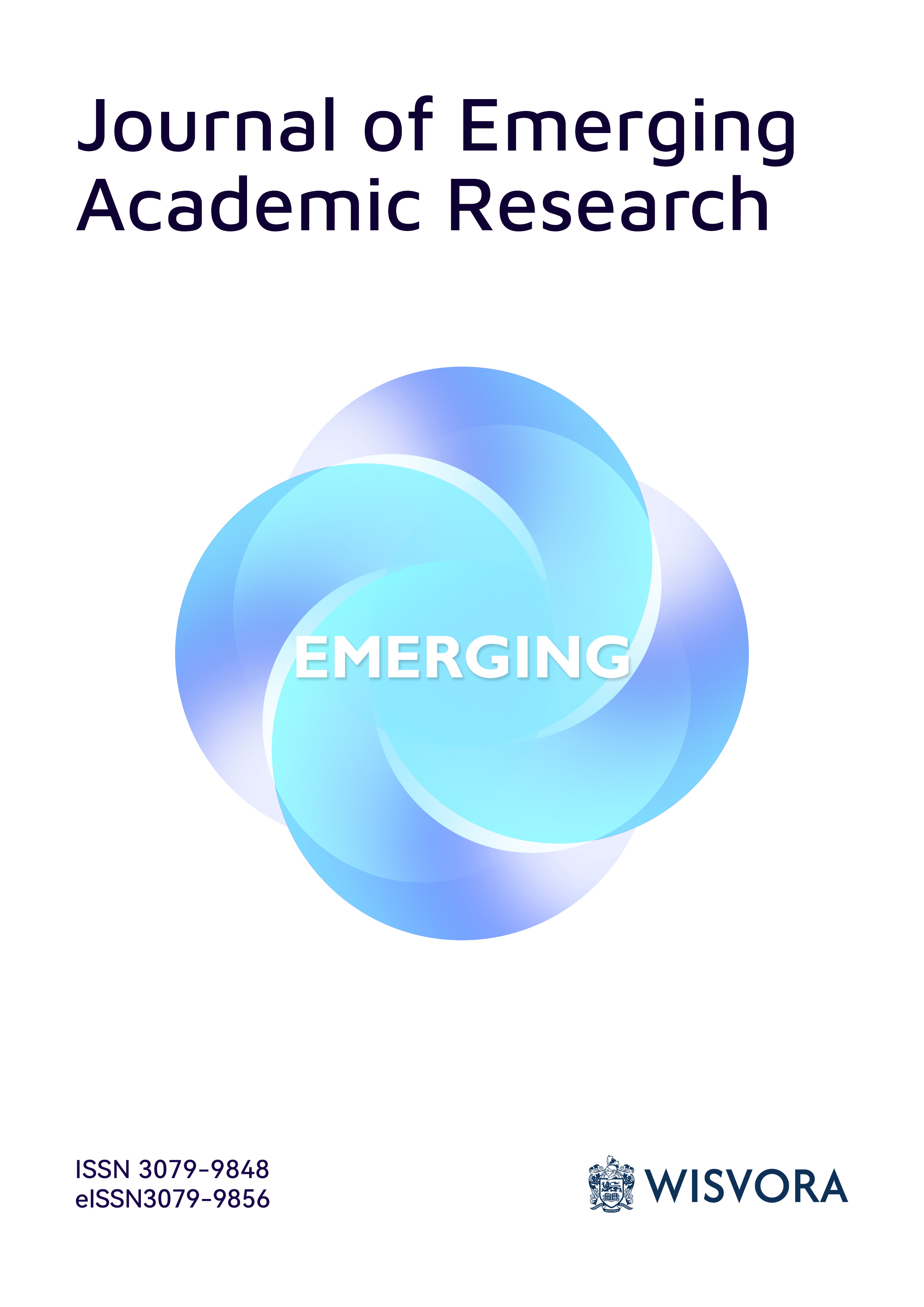Ecological Design Aesthetics: Integrating Sustainability, Functionality, and Visual Appeal
DOI:
https://doi.org/10.70693/jear.v1i1.4Keywords:
Ecological Design Aesthetics, Sustainability, Sustainable Materials, Functional Design, Visual Appeal, Minimalist DesignAbstract
This paper explores the concept of ecological design aesthetics, an emerging paradigm that integrates environmental sustainability with functionality and visual appeal in the field of design. As global environmental crises such as climate change and resource depletion intensify, designers are increasingly challenged to create products that are not only aesthetically pleasing and functional but also ecologically responsible throughout their lifecycle. The paper examines the critical role of sustainable materials, innovative production methods, and the balance between functionality and aesthetics in shaping sustainable design. Key strategies such as minimalist design, biomimicry, and emotionally durable design are discussed as methods to reconcile the tensions between beauty, utility, and sustainability. The paper also emphasizes the importance of user perception in promoting sustainable behaviors, highlighting the role of design aesthetics in communicating environmental values. Ultimately, the study underscores that ecological design aesthetics offers significant opportunities for innovation, fostering a more sustainable and aesthetically enriching future.
References
1.Aminoff, A., Faehnle, M., & Matschoss, K. (2017). Co-creation in sustainable urban development: Exploring models and practices. Sustainability, 9(7), 1238. https://doi.org/10.3390/su9071238
2.Ashby, M. F., & Johnson, K. (2019). Materials and design: The art and science of material selection in product design (4th ed.). Butterworth-Heinemann.
3.Bourrier, M. (2019). The life cycle approach in sustainable design: Challenges and opportunities. Journal of Cleaner Production, 234, 1121-1131. https://doi.org/10.1016/j.jclepro.2019.06.214
4.Carrigan, M., & Attalla, A. (2021). The influence of aesthetics on sustainable product choices: Visual cues and consumer behavior. Journal of Consumer Behaviour, 20(2), 135-148. https://doi.org/10.1002/cb.1900
5.Chapman, J. (2017). Emotionally durable design: Objects, experiences and empathy (2nd ed.). Routledge. https://doi.org/10.4324/9781315568969
6.De Jong, M. D., Harkink, K. M., & Barth, S. (2018). Making green stuff? Effects of corporate greenwashing on consumers. Journal of Business and Technical Communication, 32(1), 77-112. https://doi.org/10.1177/1050651917729863
7.Fuad-Luke, A. (2021). The Eco-Design Handbook: A Complete Sourcebook for the Home and Office (3rd ed.). Thames & Hudson.
8.Gebler, M., Schoot Uiterkamp, A. J. M., & Visser, C. (2018). A global sustainability perspective on 3D printing technologies. Energy Policy, 105, 398-410. https://doi.org/10.1016/j.enpol.2017.02.046
9.Geissdoerfer, M., Savaget, P., Bocken, N. M. P., & Hultink, E. J. (2017). The circular economy – A new sustainability paradigm? Journal of Cleaner Production, 143, 757-768. https://doi.org/10.1016/j.jclepro.2016.12.048
10.Hansen, J. (2020). The aesthetics of eco-design: Exploring the potential of sustainable materials. Materiality Journal, 34(2), 110-128. https://doi.org/10.1080/12345678.2020.567123
11.Hulme, T., & Mukherjee, A. (2019). Sustainable aesthetics: Bridging beauty and function in eco-friendly product design. Design Issues, 35(3), 75-86. https://doi.org/10.1162/desi_a_00564
12.Kampker, A., Triebs, J., Jussen, P., Heimes, H., Eickels, P., & Schnettler, A. (2019). Sustainability in mass production of electric vehicle batteries. Journal of Cleaner Production, 221, 644-656. https://doi.org/10.1016/j.jclepro.2019.02.169
13.Lilley, D., Smalley, G., Bridgens, B., & Wilson, G. T. (2021). Design for sustainable behaviour: Beyond eco-feedback in sustainable product design. Design Studies, 73, 101-125. https://doi.org/10.1016/j.destud.2020.10.001
14.Liu, L., Yang, D., Zheng, J., & Su, S. (2020). Renewable energy applications in sustainable design: A review. Renewable Energy, 146, 600-613. https://doi.org/10.1016/j.renene.2019.06.130
15.Manzini, E. (2019). Politics of the Everyday. Bloomsbury Visual Arts. https://doi.org/10.5040/9781350053827
16.Mazzarella, F. (2021). Bridging the gap between sustainable production and eco-aesthetic design: Challenges and opportunities. Design Studies, 73, 12-25. https://doi.org/10.1016/j.destud.2021.01.002
17.Mugge, R. (2020). The influence of product design on consumers’ eco-friendly perceptions. Journal of Sustainable Product Design, 39(4), 510-527. https://doi.org/10.1007/s10970-020-0501-7
18.Nguyen, L. D. (2019). Biodegradable plastics: Innovation in sustainable materials. Journal of Environmental Innovation, 12(3), 455-472. https://doi.org/10.1016/j.jenvinov.2019.05.009
19.Parsons, T. (2018). Designing for a sustainable future: A material-based approach to ecological design. Design Studies, 59, 112-131. https://doi.org/10.1016/j.destud.2018.06.001
20.Peters, A., & Dütschke, E. (2020). How visual aesthetics influence consumer acceptance of sustainable technologies: The case of electric vehicles. Renewable and Sustainable Energy Reviews, 124, 109776. https://doi.org/10.1016/j.rser.2020.109776
21.Pigosso, D. C. A., McAloone, T. C., & Rozenfeld, H. (2018). Characterizing the evolution of environmental design practices: From product eco-design to sustainable product/service systems. Journal of Cleaner Production, 172, 3398-3412. https://doi.org/10.1016/j.jclepro.2017.11.111
22.Sauerwein, M., Bakker, C., & Balkenende, R. (2019). Sustainable business model archetypes for the design of value propositions for long-lasting products. Journal of Cleaner Production, 224, 1004-1014. https://doi.org/10.1016/j.jclepro.2019.03.128
23.Schrader, S., & Kuehl, L. (2020). Bamboo as a sustainable material: Applications and challenges. Sustainable Materials Research, 5(4), 321-339. https://doi.org/10.1080/14786435.2020.1234567
24.Speck, T., Schmitt, C., & Masselter, T. (2022). Biomimicry in material innovation: Nature as a guide for sustainable solutions. Journal of Bionic Engineering, 19(1), 43-56. https://doi.org/10.1007/s12345-022-1234-5
25.Thackara, J. (2021). How to Thrive in the Next Economy: Designing Tomorrow’s World Today. Thames & Hudson.
26.Thompson, A. W., & Clarkson, P. J. (2018). Ecodesign strategies for sustainable product development: Aligning product functionality with environmental goals. Journal of Cleaner Production, 198, 755-768. https://doi.org/10.1016/j.jclepro.2018.07.012
27.Vogtlander, J. (2021). The power of sustainable materials: A comprehensive guide. Springer. https://doi.org/10.1007/978-3-030-46353-1
28.Walker, S. (2019). Sustainable by design: Explorations in theory and practice. Design and Culture, 11(2), 245-259. https://doi.org/10.1080/17547075.2019.159264
29.Walker, S. (2021). Designing sustainability: Making radical changes in a material world. Routledge. https://doi.org/10.4324/9781003038752





